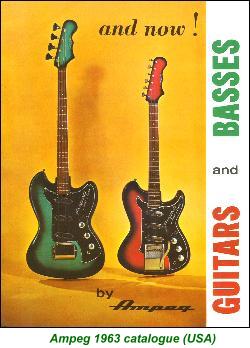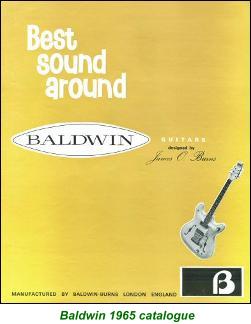 at all, but on the left-hand side, half-way along the street, I saw a sight that stopped me in my tracks.
at all, but on the left-hand side, half-way along the street, I saw a sight that stopped me in my tracks.
ONE DAY many years ago – I reckon it was in late 1962 – I was walking down a road in the centre of Middlesbrough in the North-East of England. I don’t know what I was doing in Middlesbrough, or why I was in the North-East  at all, but on the left-hand side, half-way along the street, I saw a sight that stopped me in my tracks.
at all, but on the left-hand side, half-way along the street, I saw a sight that stopped me in my tracks.
I was walking past a guitar shop in the rather slow way that guitarists do, and there, behind the glass, in the centre of the window, in pride of place so’s you couldn’t miss it was… well, I wasn’t sure what it was.
I mean, I’d played single-pickup guitars; even ventured into the realms of twin-pickup instruments myself. A three-pickup axe wasn’t an impossible dream if you had a few bob in the bank. What I hadn’t seen before – never even heard of! – was a guitar with FOUR pickups.
So I stopped; moved closer to the window, and stuck my nose against the glass. This was the first time I’d come across what we now know as the “original” ’61 Black Bison, and I’d have given my right arm to get my hands on it (I know this sentence doesn’t make sense, but I imagine you’ll know where I’m coming from).
I must have stood there for about fifteen minutes. The thing was truly droolworthy. I just had to have it. The answer was simple - just march into the shop, lay the money down, and stride off into the sunset…
Hmm, well... sadly, my name’s not Hans Christian Andersen. It would be nice to tell you of a happy ending, but I can't. I left Middlesbrough,  and that magnificent Bison stayed where it was.
and that magnificent Bison stayed where it was.
For all I know, it could be the very one gracing the front cover of Per Gjörde’s essential “Pearls And Crazy Diamonds – Fifty Years Of Burns Guitars”!
***************
In the ’50s and ’60s, Gretsch made some fantastic guitars. Innovative, certainly; quirky, definitely. Often of an inconsistent build quality, some were just plain over-the-top (think “White Falcon”!). But some were real jaw-droppers.
Sounds familiar, doesn't it? Innovative, quirky, inconsistent build quality and OTT are all terms that can justifiably be applied to the products of James Ormston Burns. But jeez, there were some real jaw-droppers.
After all, there can’t be that many guitars that, nearly half-a-century on, remain the one memory of your one and only visit to the City of Middlesbrough!
***************
|
YEARS |
COMPANIES |
GUITARS |
BASSES |
|
| 1952-1958 | (before Burns...) | Un-named 6-string
(1952)
*Supersound (1958) |
|
*More details available from the Supersound website |
| 1959-1960 | Burns-Weill | Fenton (1959)
*Super Streamline RP1G/RP2G (1959) |
Fenton (1959)
*Super Streamline RP1B/RP2B (1960) |
*Produced by Henry Weill after JB departed the Company |
| 1960-1965 | Ormston Burns London Ltd | Artist (1960)
Sonic (1960) Vibra-Artist (1960) Vibra-Artist DeLuxe (1961) *Black Bison(i) (1961-) Jazz (1962) Jazz Split Sound (1962) Split-Sonic (1962) Vista-Sonic (1962) TR2 (1963) Double Six(v) (1964) Marvin(vii) (1964) Nu-Sonic(viii) (1964) Vibraslim (1964) Baby Bison (1965) GB65 (1965) GB66 (1965) GB66 DeLuxe (1965) Virginian (1965) |
Artist (1960)
Sonic (1960) Vibra-Artist (1960) Vibra-Artist DeLuxe (1961) Split-Sonic Six String (1962) Vista-Sonic(ii) (1962) *Black Bison(iii) (1962-) TR2 (1963) Jazz(iv) (1964) Nu-Sonic (1964) Shadows(vi) (1964) Vibraslim (1964) GB66 (1965) |
*Different
models of the Black Bison guitar were introduced in 1961 (the original
4-pickup version), 1962(2),1963 & 1964. Similarly, the Black Bison
bass underwent a radical makeover in 1964
(i)The 1993 Bison is based on the '62 Black Bison guitar (ii)The 2005 Vista-Sonic 5-String Bass was named after (though not developed from) this guitar (iii)The 1993 Bison Bass is based on these guitars (iv)The 2000 Marquee Bass is based on this guitar (v)The 1994 Double Six is based on this guitar (vi)The 1993 Shadows Bass and 2006 Shadows Bass 1964 are both based on this guitar (vii)The 1992 Legend, 1998 Drifter, 1999 Marquee, 2001 Apache, 2001 Dream, 2004 Marvin, 2005 Shadows Custom Signature and the 2006 "Harrods" Guitar all have their origins in this instrument (viii)The 1995 Nu-Sonic was named after (though not developed from) this guitar |
| (1963-1964 US issues) | The Ampeg Company Inc. (USA) | *Thin Line EGT.1
(1963)
(actually a TR2) *Wild Dog EG1.S (1963) (actually a Jazz Split Sound) *Wild Dog DeLuxe EG.3 (1963) (actually a Split Sonic) *Sonic Six EGSS (1964) (actually a Nu-Sonic) |
*Wild Dog EB.1 (1963)
(actually a Vista Sonic) |
*All re-branded UK instruments |
| 1965-1970 | *Baldwin Piano &
Organ Company (USA)
*Manufactured and marketed in the UK by Baldwin-Burns Ltd |
Baby Bison (1965)
Bison (1965) Double Six (1965) GB66 DeLuxe (1965) Jazz Split Sound (1965) Marvin (1965) Vibra Slim (1965) Virginian (1965) Model 706/706V (1967) Model 712R/712T (1967) Contemporary Classic 801CP (1967) |
Baby Bison (1965)
Bison (1965) Jazz (1965) Shadows (1965) Split Sound (1965) Vibra Slim (1966) Model 704 (1967) |
In
Baldwin's 1967 Catalogue, many instruments were represented by Model Numbers
only. "Old name" equivalents are as follows:
503 = Jazz Split Sound
|
| 1966-1968 | Ormston Steel Guitars London Ltd | *Straight Eight
(1966)
*Twin Eight (1966) |
Upright Bass (1968) | *Pedal steel guitars |
| 1970-1973* | Hayman
(Dallas Arbiter Ltd) |
1010 (1970)
2020 (1970) 3030 (1971) |
4040 (1970) | *JB left Dallas Arbiter in 1971; however, these guitars continued to be manufactured in their original form until 1973 |
| 1974-1977 | Burns UK Ltd | Flyte(i)
(1974)
Artist (1976) Mirage (1976) LJ 24 (1977) |
Flyte (1974) | (i) The Flyte from 1993 is based on this guitar |
| 1979-1983 | Jim Burns Actualisers Ltd | Black Scorpion(i)
(1979)
Steer(iii) (1979) Magpie I (1980) Magpie II (1980) Marvin (1980) Bison (1981) Bandit (1983) |
Black Scorpion(ii)
(1979)
Magpie (1980) Bison (1981) |
(i)The
2002 Scorpion
Gothic is based on this guitar
(ii)The 2002 Scorpion Bass is based on this guitar (iii)The 2001 Steer is based on this guitar |
...and that was it, until Burns London Ltd brought out the “Legend” in 1992.
***************
Burns London Ltd have leaned heavily on the legacy of those five most glorious years (Ormston Burns London Ltd – 1960 to 1965). And why not?
Ultimately, they’ve succeeded in pulling off a trick that Jim Burns himself never managed; to consistently built guitars of high quality and reliability, and still make money.
Which sadly, in this evil ol' world, you gotta do...
***************
|
BURNS GUITARS SINCE 1992 Home Page |